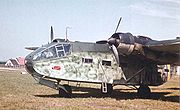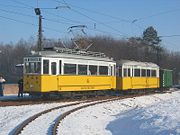
Gothaer Waggonfabrik
Encyclopedia
Gothaer Waggonfabrik was a German
manufacturer of rolling stock
established in the late nineteenth century at Gotha
. During the two world wars, the company expanded into aircraft
building.
, Gotha was the manufacturer of a highly successful series of bomber
s based on a 1914 design by Oskar Ursinus
. From 1917, these aircraft were capable of carrying out strategic bombing
missions over England
, the first heavier-than-air aircraft used in this role. Several dozen of these bombers were built in a number of subtypes - the Gotha G.I
, G.II
, G.III
, G.IV
, and G.V. This last variant was the most prolific, with thirty-six in squadron service at one point.
, Gotha returned to its railway endeavours, but returned to aviation with the rise of the Nazi
government and the abandonment of the Treaty's restrictions.
 Gotha's main contribution to the new Luftwaffe
Gotha's main contribution to the new Luftwaffe
was the Gotha Go 145
trainer
, of which 1,182 were built. The firm also produced the Gotha Go 242
assault glider
. Perhaps the most famous Gotha product of World War II
, however, was an aircraft that never actually entered service, the Horten Ho 229
. This was an exotic jet
-powered, flying wing
fighter aircraft
designed by the Horten brothers
, who lacked the facilities to mass-produce it. Two prototypes flew, the second (powered) version lost in an accident on its third flight. the third prototype- built to a modified design - was almost complete and four more were in various stages of manufacture before the end of the war.
s and light rail
vehicles in the former East Germany.

Germany
Germany , officially the Federal Republic of Germany , is a federal parliamentary republic in Europe. The country consists of 16 states while the capital and largest city is Berlin. Germany covers an area of 357,021 km2 and has a largely temperate seasonal climate...
manufacturer of rolling stock
Rolling stock
Rolling stock comprises all the vehicles that move on a railway. It usually includes both powered and unpowered vehicles, for example locomotives, railroad cars, coaches and wagons...
established in the late nineteenth century at Gotha
Gotha (town)
Gotha is a town in Thuringia, within the central core of Germany. It is the capital of the district of Gotha.- History :The town has existed at least since the 8th century, when it was mentioned in a document signed by Charlemagne as Villa Gotaha . Its importance derives from having been chosen in...
. During the two world wars, the company expanded into aircraft
Aircraft
An aircraft is a vehicle that is able to fly by gaining support from the air, or, in general, the atmosphere of a planet. An aircraft counters the force of gravity by using either static lift or by using the dynamic lift of an airfoil, or in a few cases the downward thrust from jet engines.Although...
building.
World War I
In World War IWorld War I
World War I , which was predominantly called the World War or the Great War from its occurrence until 1939, and the First World War or World War I thereafter, was a major war centred in Europe that began on 28 July 1914 and lasted until 11 November 1918...
, Gotha was the manufacturer of a highly successful series of bomber
Bomber
A bomber is a military aircraft designed to attack ground and sea targets, by dropping bombs on them, or – in recent years – by launching cruise missiles at them.-Classifications of bombers:...
s based on a 1914 design by Oskar Ursinus
Oskar Ursinus
Carl Oskar Ursinus was a pioneer of German aviation and is remembered mainly for his contributions to sailplane designs and the sport of gliding...
. From 1917, these aircraft were capable of carrying out strategic bombing
Strategic bombing
Strategic bombing is a military strategy used in a total war with the goal of defeating an enemy nation-state by destroying its economic ability and public will to wage war rather than destroying its land or naval forces...
missions over England
England
England is a country that is part of the United Kingdom. It shares land borders with Scotland to the north and Wales to the west; the Irish Sea is to the north west, the Celtic Sea to the south west, with the North Sea to the east and the English Channel to the south separating it from continental...
, the first heavier-than-air aircraft used in this role. Several dozen of these bombers were built in a number of subtypes - the Gotha G.I
Gotha G.I
The Gotha G.I was a heavy bomber used by the Luftstreitkräfte during World War I.-Design and development:In mid-1914, Oskar Ursinus, the founder and editor of the German flying magazine Flugsport, began designing a large twin-engine seaplane of unconventional configuration...
, G.II
Gotha G.II
|-See also:-References:...
, G.III
Gotha G.III
|-See also:...
, G.IV
Gotha G.IV
|-See also:...
, and G.V. This last variant was the most prolific, with thirty-six in squadron service at one point.
Inter war years
Whilst Germany was prohibited from military aircraft manufacture by the Treaty of VersaillesTreaty of Versailles
The Treaty of Versailles was one of the peace treaties at the end of World War I. It ended the state of war between Germany and the Allied Powers. It was signed on 28 June 1919, exactly five years after the assassination of Archduke Franz Ferdinand. The other Central Powers on the German side of...
, Gotha returned to its railway endeavours, but returned to aviation with the rise of the Nazi
Nazism
Nazism, the common short form name of National Socialism was the ideology and practice of the Nazi Party and of Nazi Germany...
government and the abandonment of the Treaty's restrictions.
World War II

Luftwaffe
Luftwaffe is a generic German term for an air force. It is also the official name for two of the four historic German air forces, the Wehrmacht air arm founded in 1935 and disbanded in 1946; and the current Bundeswehr air arm founded in 1956....
was the Gotha Go 145
Gotha Go 145
-See also:-Bibliography:* Bishop, C. Luftwaffe Squadrons, 1939–1945. Amber Books, 2006.* Donald, D. Warplanes of the Luftwaffe: Combat aircraft of Hitler’s Luftwaffe, 1933 -1945. Aerospace Publishing, 2001....
trainer
Trainer (aircraft)
A trainer is a class of aircraft designed specifically to facilitate in-flight training of pilots and aircrews. The use of a dedicated trainer aircraft with additional safety features—such as tandem flight controls, forgiving flight characteristics and a simplified cockpit arrangement—allows...
, of which 1,182 were built. The firm also produced the Gotha Go 242
Gotha Go 242
-External Links:* FLIGHT, 12th February 1942, p. 130, early intelligence photo of Go 242, bottom of page....
assault glider
Military glider
Military gliders have been used by the military of various countries for carrying troops and heavy equipment to a combat zone, mainly during the Second World War. These engineless aircraft were towed into the air and most of the way to their target by military transport planes, e.g...
. Perhaps the most famous Gotha product of World War II
World War II
World War II, or the Second World War , was a global conflict lasting from 1939 to 1945, involving most of the world's nations—including all of the great powers—eventually forming two opposing military alliances: the Allies and the Axis...
, however, was an aircraft that never actually entered service, the Horten Ho 229
Horten Ho 229
The Horten H.IX, RLM designation Ho 229 was a late–World War II prototype fighter/bomber designed by Reimar and Walter Horten and built by Gothaer Waggonfabrik...
. This was an exotic jet
Jet engine
A jet engine is a reaction engine that discharges a fast moving jet to generate thrust by jet propulsion and in accordance with Newton's laws of motion. This broad definition of jet engines includes turbojets, turbofans, rockets, ramjets, pulse jets...
-powered, flying wing
Flying wing
A flying wing is a tailless fixed-wing aircraft which has no definite fuselage, with most of the crew, payload and equipment being housed inside the main wing structure....
fighter aircraft
Fighter aircraft
A fighter aircraft is a military aircraft designed primarily for air-to-air combat with other aircraft, as opposed to a bomber, which is designed primarily to attack ground targets...
designed by the Horten brothers
Horten brothers
Walter Horten and Reimar Horten , sometimes credited as the Horten Brothers, were German aircraft pilots and enthusiasts, and members of the Hitler Youth and Nazi party...
, who lacked the facilities to mass-produce it. Two prototypes flew, the second (powered) version lost in an accident on its third flight. the third prototype- built to a modified design - was almost complete and four more were in various stages of manufacture before the end of the war.
Post war
Following the war, Gotha once again returned to its original purpose, building tramTram
A tram is a passenger rail vehicle which runs on tracks along public urban streets and also sometimes on separate rights of way. It may also run between cities and/or towns , and/or partially grade separated even in the cities...
s and light rail
Light rail
Light rail or light rail transit is a form of urban rail public transportation that generally has a lower capacity and lower speed than heavy rail and metro systems, but higher capacity and higher speed than traditional street-running tram systems...
vehicles in the former East Germany.

List of aircraft
Gotha aircraft included:- Gotha Go 145Gotha Go 145-See also:-Bibliography:* Bishop, C. Luftwaffe Squadrons, 1939–1945. Amber Books, 2006.* Donald, D. Warplanes of the Luftwaffe: Combat aircraft of Hitler’s Luftwaffe, 1933 -1945. Aerospace Publishing, 2001....
, trainer - Gotha Go 146, small transport (twin-engine), 1935
- Gotha Go 147Gotha Go 147The Gotha Go 147 was a German experimental prototype reconnaissance aircraft designed in 1936. Designed by Gothaer Waggonfabrik and Albert Kalkert, construction of the two-seater aircraft was abandoned before the end of World War II....
, STOL reconnaissance (prototype) - Gotha Go 229, fighter (flying-wing)
- Gotha Go 242Gotha Go 242-External Links:* FLIGHT, 12th February 1942, p. 130, early intelligence photo of Go 242, bottom of page....
, transport glider - Gotha Go 244Gotha Go 244-See also:-References:NotesBibliography...
, transport - Gotha Go 345Gotha Go 345The Gotha Go 345 was a prototype German Military glider of the Second World War. A single example was tested in 1944.-References:* Green, William. Warplanes of the Third Reich. New York:Doubleday, 1972. ISBN 0-385-05782-2.-External links:*...
, assault glider - Gotha Ka 430Gotha Ka 430|-References:* *...
, transport glider - Gotha Taube a variation of the Etrich Taube

